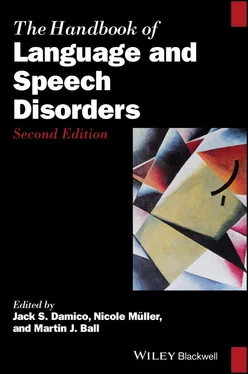Holt et al. (2017) found that adults with CIs, in a task where interlocutors were asked to direct each other around a map, used repetition of directives more often than information requests, as a request for clarification, and also fewer acknowledgments than NH counterparts. Moreover, their final rise excursions for questions, which were normally large, as opposed to statements, which were normally small or non‐existent, was opposite to those of the control participants. This shows that their usage and realization of pragmatics in language was essentially different from NH controls.
The above literature suggests that CIs improve non‐objective higher‐order communication relative to the pre‐implant period, but that many aspects of the pragmatics of communication deviate from those of NH peers. Many issues are yet to be thoroughly investigated. Sarant et al. (2018) argued that impaired prosocial behavior that can be observed in CI children may be due to issues, some of which have been reported, for children with hearing loss, such as reduced access to speech due to, for instance, a late onset of acquisition, difficulty with hearing in noise, poor quality of speech input, reduced amount of overhearing or eavesdropping, reduced child‐directed input or parental attention, increased listening effort, and shame in expressing oneself. Children ( n = 188) with delayed expressive and receptive oral language development spent less time communicating with their parents and had reduced sustained attention, as revealed by the percentage of time dedicated to playing, during free play than their NH peers (Barker et al., 2009). According to the authors, the results supported the hypothesis that attention deficits, and not communication skills, mediated the effect of language problems on behavior, which opens up new avenues of investigation for the study of the long‐term effects of cochlear implantation on the higher‐order communication of children.
3.4 Auditory Brainstem Implants
A device that is essentially similar to CIs is the auditory brainstem implant (ABI). ABI systems were developed to address the auditory communication needs of patients with neurofibromatosis type‐2 (NF‐2), but have also been used with non‐tumor patients, and sometimes children, when cochlear implantation is contraindicated (Goffi‐Gomez et al., 2012). NF‐2 patients have usually undergone extensive neurosurgical intervention, at the end of which the ABI is positioned according to intraoperatively recorded electrically evoked potentials and acoustic reflexes. The ABI electrically stimulates the cochlear nucleus with an array of electrodes that are mounted on a “paddle.” One complication that has been reported is that, despite peri‐surgical efforts to position the paddle optimally, there may be in‐situ migration, particularly in children due to head growth (Sennaroğlu et al., 2016). Apart from the differences in electrode array and positioning, the hardware and the processing involved in an ABI are identical to that of a CI.
Some ABI recipients may be able to use their implant to listen, such that their speech‐perceptual performance is on a par with that of their CI counterparts, some even attaining the ability to use the telephone (Siegbahn et al., 2014). Listening performance with the implant is thought to be unrelated to the disease process, as excellent speech recognition performance has been reported in both NF‐2 and non‐NF‐2 patients alike (Colletti, Shannon, & Colletti, 2012). Instead, the overall poorer performance that is generally seen in ABI speech‐perceptual performance is thought to be related to iatrogenic complications and device issues or differences. Therefore, for many ABI recipients, the benefit provided by the implant will support low‐level tasks, including awareness of ambient sounds and support for speech‐reading, while nuanced speech‐perceptual tasks like prosody perception and higher‐order levels of communication will be unattainable.
3.5 Conclusions and Perspectives
If we cross‐reference the audiometric output from an International Standard (ISO 7029) describing nonpathological hearing loss with population data, we find that many of us during our lifetime will experience some degree of hearing loss. This trend will have broad implications for our healthcare service, our society, and for us as individuals. Furthermore, recent advances in our understanding of the underlying causes of early‐stage hearing loss indicate that noise exposure has insidious subclinical effects.
While cochlear implantation is known as the most successful sensory prosthesis to date, inherent limitations in the passage of an acoustic signal directly to the auditory nerve entails some signal degradation, and this is known as the electrical–neuronal perceptual bottleneck. Research findings on the most fundamental goal of CIs, improving communication relative to pre‐implantation expressive and productive ability, have been reviewed. Although CI users are successful in their attainment of some communication objectives, problems remain on all levels of perception and production of language, and of communication in a broader sense. On the phonetic level of speech perception, CI users identify vowels and consonants less successfully than NH individuals, with consonants posing more trouble than vowels. Segments that share spectral properties are more difficult to distinguish. This is in line with the fundamental difficulty that CI recipients evince in perceiving the frequency‐related as opposed to the intensity‐related and temporal dimensions of the auditory signal. In production, CI children have a reduced consonant inventory and smaller vowel space. The impaired pitch perception problems lead to CI listeners missing out on prosodic aspects of speech, such as the signaling of information structure and emotions, issues that in turn may compromise socio‐emotional development in prelingually implanted children. Their prosody production is characterized by a diminished contrast in linguistic (statements vs. questions) and emotional (sad vs. happy) prosody.
CI recipients’ word identification is less compromised than that of the lower level of segments, probably due to an ability to make use of contextual cues. There is evidence that perceptual abilities measured on the phonetic level are partly responsible for those that affect the word level. CI users tend to have a relatively normal sized lexical vocabulary, but their morphosyntactic development lags behind that of their NH peers, a developmental trajectory that is partly dependent on lower‐level abilities, such as phonetic perception. The pragmatic, supralinguistic level of communication in a general sense is impaired, although literacy development is often found to be commensurate with NH controls. These communication issues might, among other factors, have to do with reduced intelligibility. In turn, they might be one of the factors underlying even more global developmental issues, such as behavior and quality of life (Fortunato‐Tavares et al., 2012; Wiefferink et al., 2013).
The cross‐level and task results reviewed in this chapter support the basic assumption that higher‐level communication may be determined, in part, by lower‐level perceptual ability (Huber & Havas, 2019; Wilson & Cleary, 1995), and they thus justify our inclusion of this framework. However, in discussing influences on outcomes, it must be borne in mind that there is much individual variation. Some important factors identified were the negative effect of later age at implantation and the positive effect of longer duration of device usage. For a more complete description of factors, we direct the interested reader to recent reviews (e.g., Gillis, 2018). Research on this complex network of factors remains topical, especially when it can draw on outcomes from large cohorts. Another direction for future research is a reevaluation of—especially long‐term—higher‐level communication abilities, such as discourse strategies (including, turn‐taking, initiative in discourse), speech act usage, and understanding of others’ beliefs, to name a few areas. It has already been proposed that rehabilitation aimed at improving a basic layer of linguistic competition and phonological representations assists in the development of higher cognitive functioning (Lazard, Giraud, Gnansia, Meyer, & Sterkers, 2012). However, more work is required to better define the type and extent of the rehabilitation supporting processing of speech information, for example, vocal emotions (Jiam et al., 2017). To this end, musical training may be a promising avenue (Torppa & Huotilainen, 2019).
Читать дальше












